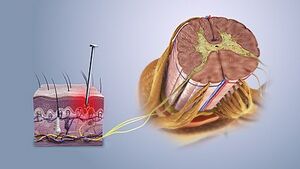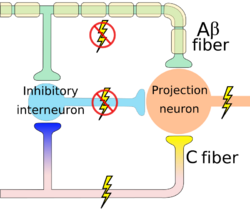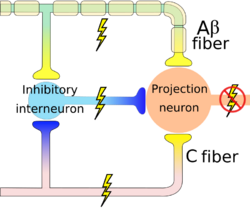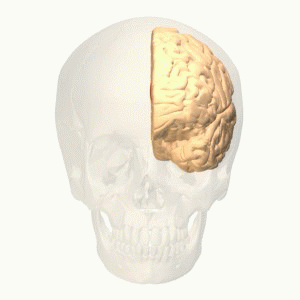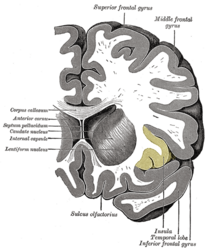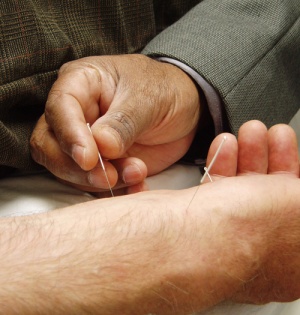Pain-Modulation: Difference between revisions
No edit summary |
No edit summary |
||
| Line 1: | Line 1: | ||
<div class="editorbox"> '''Original Editor '''- [[User:Khloud Shreif|Khloud Shreif]] '''Top Contributors''' - {{Special:Contributors/{{FULLPAGENAME}}}}</div> | <div class="editorbox"> '''Original Editor '''- [[User:Khloud Shreif|Khloud Shreif]] '''Top Contributors''' - {{Special:Contributors/{{FULLPAGENAME}}}}</div> | ||
== Pain Modulation == | == Pain Modulation == | ||
[[File:Nociceptive pain.jpg|thumb|Sensory afferent]] | |||
[[Pain Mechanisms|Pain]] modulation the process of alterations in the pain signals along the transmission pathway of pain, it explains why individuals response to the same stimulus different, explains the mechanism of action when using clinical analgesic. Pain control and modulation is a complex chore that is often the primary reason patients seek the services of rehabilitation professionals. Modulation of pain begins with an understanding of the various levels of pain modulation and extends to clinical interventions and protocols designed to reduce pain. For example, opiates they are capable of increasing and decreasing pain experience. | [[Pain Mechanisms|Pain]] modulation the process of alterations in the pain signals along the transmission pathway of pain, it explains why individuals response to the same stimulus different, explains the mechanism of action when using clinical analgesic. Pain control and modulation is a complex chore that is often the primary reason patients seek the services of rehabilitation professionals. Modulation of pain begins with an understanding of the various levels of pain modulation and extends to clinical interventions and protocols designed to reduce pain. For example, opiates they are capable of increasing and decreasing pain experience. | ||
== Levels of Pain Modulation == | == Levels of Pain Modulation == | ||
| Line 61: | Line 55: | ||
A systematic review delivred by Arribas-Romano A, et al 2020, demonstrated that the physiotherapy modalities can alert pain perception with chronic musckloskeletal pain CMP through a decrease in temporal summation, increase conditioned pain modulation, and a slight improvement in central sensitization, and the manual therapy and [[Strength Training|strengthening exercises]] were the most effective to produce these changes<ref name=":1">Arribas-Romano A, Fernández-Carnero J, Molina-Rueda F, Angulo-Diaz-Parreño S, Navarro-Santana MJ. [https://academic.oup.com/painmedicine/article/21/10/2502/5757972 Efficacy of physical therapy on nociceptive pain processing alterations in patients with chronic musculoskeletal pain: a systematic review and meta-analysis.] Pain Medicine. 2020 Oct;21(10):2502-17.</ref>. Combination of more than technique demonstrated a significant increase in conditioned pain modulation. | A systematic review delivred by Arribas-Romano A, et al 2020, demonstrated that the physiotherapy modalities can alert pain perception with chronic musckloskeletal pain CMP through a decrease in temporal summation, increase conditioned pain modulation, and a slight improvement in central sensitization, and the manual therapy and [[Strength Training|strengthening exercises]] were the most effective to produce these changes<ref name=":1">Arribas-Romano A, Fernández-Carnero J, Molina-Rueda F, Angulo-Diaz-Parreño S, Navarro-Santana MJ. [https://academic.oup.com/painmedicine/article/21/10/2502/5757972 Efficacy of physical therapy on nociceptive pain processing alterations in patients with chronic musculoskeletal pain: a systematic review and meta-analysis.] Pain Medicine. 2020 Oct;21(10):2502-17.</ref>. Combination of more than technique demonstrated a significant increase in conditioned pain modulation. | ||
=== Manual Therapy === | === [[Manual Therapy]] === | ||
Manual therapy showed an increase in the activity of cortical pain modulatory regions such as the insular cortex RAIC and periaqueductal gray substance PAG<ref name=":1" />. | Manual therapy showed an increase in the activity of cortical pain modulatory regions such as the insular cortex RAIC and periaqueductal gray substance PAG<ref name=":1" />. | ||
* Myofascial release and Message. | * Myofascial release and [[Massage|Message]]. | ||
* Joint mobilization, low-velocity mobilizations<ref name=":1" />. | * Joint [[Mobilization Grades|mobilization]], low-velocity mobilizations<ref name=":1" />. | ||
* Spinal manipulative therapy: reduces the pain expectancy and strain occurs with exercise<ref>Ellingsen DM, Napadow V, Protsenko E, Mawla I, Kowalski MH, Swensen D, O'Dwyer-Swensen D, Edwards RR, Kettner N, Loggia ML. [https://www.ncbi.nlm.nih.gov/pmc/articles/PMC6220681/ Brain mechanisms of anticipated painful movements and their modulation by manual therapy in chronic low back pain. The journal of pain]. 2018 Nov 1;19(11):1352-65.</ref> | * [[Spinal Manipulation|Spinal manipulative]] therapy: reduces the pain expectancy and strain occurs with exercise<ref>Ellingsen DM, Napadow V, Protsenko E, Mawla I, Kowalski MH, Swensen D, O'Dwyer-Swensen D, Edwards RR, Kettner N, Loggia ML. [https://www.ncbi.nlm.nih.gov/pmc/articles/PMC6220681/ Brain mechanisms of anticipated painful movements and their modulation by manual therapy in chronic low back pain. The journal of pain]. 2018 Nov 1;19(11):1352-65.</ref> | ||
=== Modalities === | === Modalities === | ||
| Line 76: | Line 70: | ||
An important modality to reduce perception in chronic pain conditions and proved to has a significant difference when compared to a sham technique<ref>Mylius V, Borckardt JJ, Lefaucheur JP. Noninvasive cortical modulation of experimental pain. Pain. 2012 Jul 1;153(7):1350-63.</ref>. The precentral cortical area of motor cortex is the most target area for pain modulation. | An important modality to reduce perception in chronic pain conditions and proved to has a significant difference when compared to a sham technique<ref>Mylius V, Borckardt JJ, Lefaucheur JP. Noninvasive cortical modulation of experimental pain. Pain. 2012 Jul 1;153(7):1350-63.</ref>. The precentral cortical area of motor cortex is the most target area for pain modulation. | ||
'''[[Transcutaneous Electrical Nerve Stimulation (TENS)|Transcutaneous Electrical Nerve Stimulation]] (TENS).''' TENS mechanism depend on gate control theory and release of endorhine and encephalin. | |||
* [[Low Level Laser Therapy|'''Low Level Laser Therapy.''']] | |||
* '''[[Acupuncture]]''' | * '''[[Acupuncture]]''' | ||
| Line 83: | Line 78: | ||
Acupuncture are used as complementary modality for pain management, and it is mechanism depend on releasing of endogenous opioids, serotonin, and norepinephrine<ref name=":0">Kelly RB, Willis J. [https://www.aafp.org/afp/2019/0715/p89.html Acupuncture for pain.] American family physician. 2019 Jul 15;100(2):89-96.</ref>. The variability in it’s effect may refer to the method of application, number of needles, and duration of application. There are studies with low to moderate quality demonstrated decrease in pain intensity with modest benefits specially with chronic pain( chronic low back pain, tension headache, chronic headache, migraine headache, and myofascial pain)<ref>Skelly AC, Chou R, Dettori JR, Turner JA, Friedly JL, Rundell SD, Fu R, Brodt ED, Wasson N, Winter C, Ferguson AJ. Noninvasive nonpharmacological treatment for chronic pain: a systematic review.</ref>and slight improvement with acute conditions and this improvement is not clinically significant and may refer it to the placebo effect and other RCT there was no difference between sham and verum acupuncture and it may be used with patients who are not tolerable to other standard therapies<ref name=":0" />. | Acupuncture are used as complementary modality for pain management, and it is mechanism depend on releasing of endogenous opioids, serotonin, and norepinephrine<ref name=":0">Kelly RB, Willis J. [https://www.aafp.org/afp/2019/0715/p89.html Acupuncture for pain.] American family physician. 2019 Jul 15;100(2):89-96.</ref>. The variability in it’s effect may refer to the method of application, number of needles, and duration of application. There are studies with low to moderate quality demonstrated decrease in pain intensity with modest benefits specially with chronic pain( chronic low back pain, tension headache, chronic headache, migraine headache, and myofascial pain)<ref>Skelly AC, Chou R, Dettori JR, Turner JA, Friedly JL, Rundell SD, Fu R, Brodt ED, Wasson N, Winter C, Ferguson AJ. Noninvasive nonpharmacological treatment for chronic pain: a systematic review.</ref>and slight improvement with acute conditions and this improvement is not clinically significant and may refer it to the placebo effect and other RCT there was no difference between sham and verum acupuncture and it may be used with patients who are not tolerable to other standard therapies<ref name=":0" />. | ||
[[Dry needling|Dry needling.]] | * [[Dry needling|'''Dry needling.''']] | ||
* '''[[Interferential Therapy / Interferential Current (IFC)]]''' | |||
=== Exercise === | === Exercise === | ||
For how exercise affect on pain and what are recommended exercises you can read: [[Exercise and Activity in Pain Management]] | |||
== Resources == | == Resources == | ||
Revision as of 10:18, 14 December 2021
Pain Modulation[edit | edit source]
Pain modulation the process of alterations in the pain signals along the transmission pathway of pain, it explains why individuals response to the same stimulus different, explains the mechanism of action when using clinical analgesic. Pain control and modulation is a complex chore that is often the primary reason patients seek the services of rehabilitation professionals. Modulation of pain begins with an understanding of the various levels of pain modulation and extends to clinical interventions and protocols designed to reduce pain. For example, opiates they are capable of increasing and decreasing pain experience.
Levels of Pain Modulation[edit | edit source]
Pain modulation is easily classified into 5 discreet levels of interaction. These levels correspond to either important synaptic junctions, or significant chemical processes involved in the transmission of pain.
Level 1: Periphery[edit | edit source]
Level 1 pain modulation refers to events acting in the periphery of the body, at the source of the pain source. The somatosensation defined as the sensation from skin, mucus, limbs, and joints and classified into: thermoception, nociception, equilibrioception mechanoreception response to (vibration, touch, and pressure), and proprioception.
Nociceptors are peripheral cell nerve endings that initiate pain sensation, respond to noxious stimulus (thermal, mechanical, or chemical) which in turn trigger action potential to the spinal cord and to higher centers. It is divided into A delta and C fibers.
- A- delta fibers are large(larger than C- fiber) myelinated, fast conducting fibers, concerned with localized, sharp, and fast sensation of pain.
- C- fibers are small, unmyelinated, slow conducting nerve fibers, concerned with dull, and slow pain sensation.
Under normal conditions the nociceptors are inactive when there is a noxious stimulus (tissue damage) those pain receptors respond according to the stimulus type and cyclooxygenase-2 is activated to release more PG(prostaglandin) at the site of injury, and the nociceptors will transmit signals to the dorsal horn of spinal cord (first order neuron) where the firs neuron release chemical substance P to transmit signals..
A- beta are myelinated, large diameter, and have the fastest conduction velocity. These fibers respond to non painful stimulus such as touch sensation, mild pressure, and vibration. A beta stimulated by deep touch that explain why rubbing the painful site relief your pain[1][2].
Level 2: Dorsal Horn[edit | edit source]
Level 2 pain modulation refers to events in the dorsal horn of the spinal cord. The modulation at the level of spinal cord take place at Substantial Gelatenosa of Ronaldo SG under the theory of gait control theory GCT, it was proposed for first time in 1965 by Ronald Melzack and Patrick Wall, this theory explain pain transmission and modulation depending on large(A-Beta) and small (C-fibers) sensory fibers. At homeostasis conditions the gait is closed and no pain signals are transmitted (the inhibitory interneuron I block the projection neuron which transmit pain signals and connect to the brain).
When small nociceptors fibers are stimulated by noxious stimulus action potential signals are transmitted which in turn inhibit the inhibitory interneuron (I) and the projection neuron is activated the gate is opened and pain signal are transmitted to the brain. When action potential transmits through the first order neuron that in turn activate the vesicles to release the substance P which propagate the transmission of pain signals.
If large sensory fibers(A-Beta) activated by deep touch for example the transmitted signals activate the inhibitory interneuron and which blocks the projection neuron, the gate is close and no pain[3]. Interruption of pain signals at dorsal horn affect on spinothalamic tract to the cortex.
The modulation at the level of spinal cord produce localized analgesic effect and it receive another control from the descending pathway to cause diffuse inhibition of pain.
Level 3: Fast Neuronal Descending Pathways and Endogenous[edit | edit source]
The descending inhibitory pathway/ pain modulation mechanism depend on the release of opioids at the SG it controls/ inhibits signals transmission between the the 1st and 2nd order neuron. The descending pathway start from periaqueductal gray matter PAG in the midbrain, then to raphe nucleus in the medulla to the dorsal horn of spinal cord where:
These pathways release serotonin and noradrenergic neuron to inhibit the release of substance P from the presynaptic cleft of the first order neuron.
Stimulate the inhibitory interneuron to release opioids (endorphin, enkephalin) which in turn inhibit the presynaptic form releasing substance P and inhibit the post synapse of the second order neuron from transmitting signals.
Level 4: Cortical[edit | edit source]
The noxious stimulus transmit to the cortex via spinothalamic tract that relay as a 3rd interneuron in the somatosensory area. Pain signals at the cortex induce pain modulation by two mechanisms:
- The cortex activate the PAG in the midbrain to activate the descending pathway (top down control of pain ) that interrupt and inhibit pain signals at the dorsal horn as mentioned before, so by extension the spinothalamic tract is inhibited[5].
- The interaction between different areas; cerebral cortex, limbic forebrain structures, basal ganglia, importance of this interaction is to perceive the noxious but as a non painful. For example activation of Anterior cingulate cortex (ACC) and the Rostral agranular insular cortex (RAIC) by noxious stimulus showed activation of these area and increase in the regional cerebral blood flow (rCBF) to these area. ACC plays a role in pain transmission and believed to be related to placebo analgesia and has a role with conditioned learning[6][7].
Rostral agranular insular cortex also affect on the descending inhibitory pathway and is responsible for pain learning and memory. There is a study suggest that paraventricular hypothalamic nucleus send projections of oxytocinergic that support GABA neurotransmission and activate descending spinal noradrenergic mechanisms[8].
Physical Therapy Interventions for Pain Modulation.[edit | edit source]
A systematic review delivred by Arribas-Romano A, et al 2020, demonstrated that the physiotherapy modalities can alert pain perception with chronic musckloskeletal pain CMP through a decrease in temporal summation, increase conditioned pain modulation, and a slight improvement in central sensitization, and the manual therapy and strengthening exercises were the most effective to produce these changes[9]. Combination of more than technique demonstrated a significant increase in conditioned pain modulation.
Manual Therapy[edit | edit source]
Manual therapy showed an increase in the activity of cortical pain modulatory regions such as the insular cortex RAIC and periaqueductal gray substance PAG[9].
- Myofascial release and Message.
- Joint mobilization, low-velocity mobilizations[9].
- Spinal manipulative therapy: reduces the pain expectancy and strain occurs with exercise[10]
Modalities[edit | edit source]
- Transcranial magnetic stimulation/ direct current stimulation.
An important modality to reduce perception in chronic pain conditions and proved to has a significant difference when compared to a sham technique[11]. The precentral cortical area of motor cortex is the most target area for pain modulation.
Transcutaneous Electrical Nerve Stimulation (TENS). TENS mechanism depend on gate control theory and release of endorhine and encephalin.
Acupuncture are used as complementary modality for pain management, and it is mechanism depend on releasing of endogenous opioids, serotonin, and norepinephrine[12]. The variability in it’s effect may refer to the method of application, number of needles, and duration of application. There are studies with low to moderate quality demonstrated decrease in pain intensity with modest benefits specially with chronic pain( chronic low back pain, tension headache, chronic headache, migraine headache, and myofascial pain)[13]and slight improvement with acute conditions and this improvement is not clinically significant and may refer it to the placebo effect and other RCT there was no difference between sham and verum acupuncture and it may be used with patients who are not tolerable to other standard therapies[12].
Exercise[edit | edit source]
For how exercise affect on pain and what are recommended exercises you can read: Exercise and Activity in Pain Management
Resources[edit | edit source]
UTHealth, the university of Texas
References[edit | edit source]
- ↑ Purves D, Augustine GJ, Fitzpatrick D, Katz LC, LaMantia AS, McNamara JO, Williams SM. Nociceptors. Sunderland, MA. 2001.
- ↑ Yam MF, Loh YC, Tan CS, Khadijah Adam S, Abdul Manan N, Basir R. General pathways of pain sensation and the major neurotransmitters involved in pain regulation. International journal of molecular sciences. 2018 Aug;19(8):2164.
- ↑ Yam MF, Loh YC, Tan CS, Khadijah Adam S, Abdul Manan N, Basir R. General pathways of pain sensation and the major neurotransmitters involved in pain regulation. International journal of molecular sciences. 2018 Aug;19(8):2164.
- ↑ Armando Hasudungan. PAIN! Physiology - The Ascending Pathway, Descending Pain Pathway and the Substantia Gelatinosa. Available from: http://www.youtube.com/watch?v=5c8maFAhqIc[last accessed 11/12/2021]
- ↑ Ohara PT, Vit JP, Jasmin L. Cortical modulation of pain. Cellular and Molecular Life Sciences CMLS. 2005 Jan;62(1):44-52.
- ↑ Xie YF, Huo FQ, Tang JS. Cerebral cortex modulation of pain. Acta Pharmacologica Sinica. 2009 Jan;30(1):31-41.
- ↑ Steeds CE. The anatomy and physiology of pain. Surgery (Oxford). 2009 Dec 1;27(12):507-11.
- ↑ Gamal-Eltrabily M, de Los Monteros-Zúñiga AE, Manzano-García A, Martínez-Lorenzana G, Condés-Lara M, González-Hernández A. The rostral agranular insular cortex, a new site of oxytocin to induce antinociception. Journal of Neuroscience. 2020 Jul 15;40(29):5669-80.
- ↑ 9.0 9.1 9.2 Arribas-Romano A, Fernández-Carnero J, Molina-Rueda F, Angulo-Diaz-Parreño S, Navarro-Santana MJ. Efficacy of physical therapy on nociceptive pain processing alterations in patients with chronic musculoskeletal pain: a systematic review and meta-analysis. Pain Medicine. 2020 Oct;21(10):2502-17.
- ↑ Ellingsen DM, Napadow V, Protsenko E, Mawla I, Kowalski MH, Swensen D, O'Dwyer-Swensen D, Edwards RR, Kettner N, Loggia ML. Brain mechanisms of anticipated painful movements and their modulation by manual therapy in chronic low back pain. The journal of pain. 2018 Nov 1;19(11):1352-65.
- ↑ Mylius V, Borckardt JJ, Lefaucheur JP. Noninvasive cortical modulation of experimental pain. Pain. 2012 Jul 1;153(7):1350-63.
- ↑ 12.0 12.1 Kelly RB, Willis J. Acupuncture for pain. American family physician. 2019 Jul 15;100(2):89-96.
- ↑ Skelly AC, Chou R, Dettori JR, Turner JA, Friedly JL, Rundell SD, Fu R, Brodt ED, Wasson N, Winter C, Ferguson AJ. Noninvasive nonpharmacological treatment for chronic pain: a systematic review.
